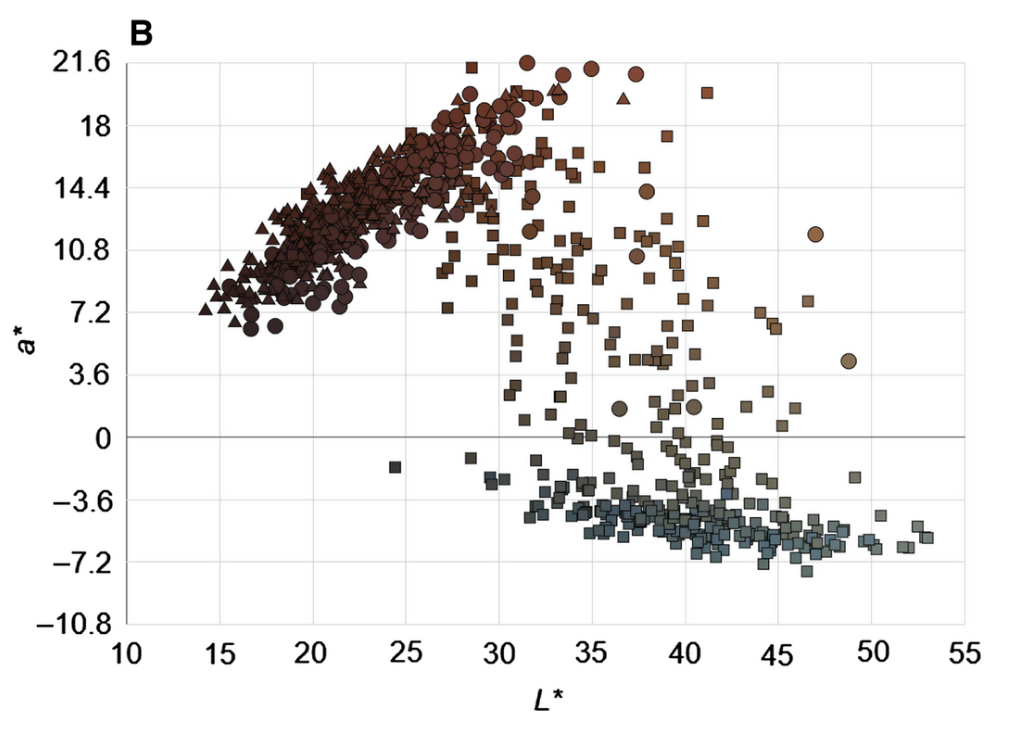Look into my eyes
What color are your eyes?
There are many ways to answer that question. Statistically speaking, they’re probably brown. Unless you’re from northern Europe, in which case they’re probably blue.

But what about green eyes? Or hazel, amber, grey, or shades in between? If you’ve ever looked deeply into someones eyes, you know for a fact that calling eyes “brown” or “blue” is as reductionist as a government form.

Eye color can be described quantitatively. This study from December 2015 examined high resolution photos of the irises of 1465 people. They interpolated a single color value from a 256×256 pixel square of each iris, and plotted the results on a scatter plot in CIELAB color space with shape representing the participant’s country of origin.

The study shows that eye color is highly correlated with the participant’s origin (and, by extension, likely ancestry) and goes on to look at the genes responsible for color variation.
Can genetics accurately predict the color of an individual’s eyes?
Mendelian eye color is a recessive theory
Eye color was once believed to be due to simple Mendelian inheritance. Brown indicated a dominant trait, blue was recessive, and any other color was hand-wavingly explained as a mix between the two.
But it is possible (though not common) for blue-eyed parents to have a child with non-blue eyes. Simple Mendelian inheritance can’t explain this.
Genetic sequencing has shown that the real story is, as usual, a lot more complex.
Eye color (as well as hair and skin color) seems to be determined by the concentration and type of melanins present. The melanins responsible for eye color include two flavors of eumelanin (brown and black) and pheomelanin, which appears pink-to-red. The mixing of concentration of these pigments determines your eye color. And your genes determine how much of each is likely to be produced by your body.
But which genes? And why?
While research is still ongoing, this area was heavily investigated in 2008 (mostly in European populations).
Here is a study that identifies several SNPs, which are also correlated with skin and hair color.
This paper demonstrates that two SNPs (rs12913832 and rs1129038) show a perfect association with blue eye color for a large Danish family. They go on to show that the region in which the SNPs occur is highly conserved (even in horses, cows, cats, dogs, rhesus monkeys, mice, and rats), possibly indicating a founder mutation. But these two SNPs alone can’t account for the wide spectrum of iris color variation.
Another study implicates two additional SNPs (rs916977 and rs1667394) as being essential to identifying eye color.
23andMe uses rs12913832 as the definitive SNP, giving relative percentages of the likelihood of brown, green, or blue eyes on this call alone.
I signed up for 23andMe a couple of years ago (before their trouble with the FDA, which has thankfully passed). I have those results, and I can correlate their call with my recent WGS results. Fortunately the calls agree in this case. (This isn’t always true, due to technical differences in how the analysis is performed).
Here are my calls for several SNPs from the above studies. Depth refers to allelic depth. Humans are diploid, with two copies of each chromosome (allowing for variation in zero, one, or both copies). The first number indicates the number of reads supporting a call for the reference base, the other for the alternate (ROB) base. A zero in either place is a homozygous call; non-zero numbers in both places are heterozygous.
CHR LOCATION SNP REF ROB DEPTH GENE
15 28365618 rs12913832 A G 0,34 HERC2
15 28356859 rs1129038 C T 0,22 HERC2
15 28513364 rs916977 T C 19,19 HERC2
15 28530182 rs1667394 C T 0,30 HERC2
15 28230318 rs1800407 C T 17,16 OCA2
14 92773663 rs12896399 G T 15,13 SLC24A4
5 33951693 rs16891982 C G 40,0 SLC45A2
11 89011046 rs1393350 G G 33,0 TYR
6 396321 rs12203592 C T 14,11 IRF4The verdict: Almost certainly blue.

The genetics of eye color are a well-traveled path of research, but there is clearly still a lot of work to be done. The European bias of current research probably helps in my case, since I happen to be of European descent. But you can expect an even more complex story to unfold as we study Africa, China, the Pacific Rim, South America, and the rest of the melanin-rich world.
An immense amount of work has been done to tie genetics to something as easily observable as eye color. Now try to imagine the effort necessary to understand the genetic basis of more complex conditions like autism, cancer, schizophrenia, Alzheimer’s, aging… Especially if we’re not even certain that the dominant factor is genetic.
Computational genomics is certainly going to help extend human life and cure genetic disease. But the problem is vast, and we’re in a race for our lives. It’s going to be a long and tough fight.